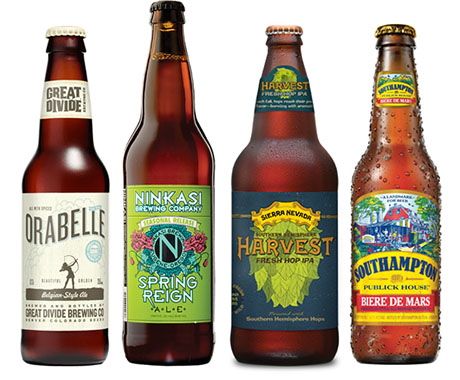
IMAGE: Great Divide’s Orabelle, Ninkasi’s Spring Reign, Sierra Nevada’s Southern Hemisphere Harvest, and Southampton’s Bière de Mars beers.
I spent some trying to track down traditional spring beers for Gizmodo, and ended up finding that, unlike the other seasons, there isn’t really any such thing. I did find a Lenten beer that you can live on for forty-six days without noticeable harm (medieval monks used to, and a journalist managed it in 2011), as well as a delightful-sounding Franco-Belgian style called bière de Mars that we’ve sadly forgotten how to make altogether (a drinking buddy of mine, Daniel Fromson, just wrote about it for Modern Farmer).
I also talked to Jeff Alworth, Portland-based author of the Beervana blog and The Beer Bible (forthcoming in Spring 2015), who shared some interesting insights into how the seasonal American craft brew market works. Taken as a whole, seasonal releases are an extremely popular category of craft beer, with a supermarket sales volume second only to IPA. Typically, each brewery will be allocated one SKU or shelf slot for their seasonal offering, so you’re unlikely see an Oktoberfest and a winter ale from the same company side-by-side.
The problem, as Jamie Emmerson of Oregon’s Full Sail brewery (one of my personal favourites) told Alworth, is that American consumers won’t buy a winter beer after January 1st.
Winter beer sales just completely drop off the map, even though January 1st is still the dead of winter. If they have winter beers sitting out on the shelf in that slot on January 1, they just don’t sell. And so then they have to come up with some kind of beer that’s sort of a spring seasonal, but, you know, it’s still January.
This leads to the free-for-all I describe in my Gizmodo post, with springiness translating into everything from a dark brown ale to a hazy, refreshing saison. Alworth added that true beer nerds get quite wound up about this kind of season inflation, accusing breweries of pursuing novelty for the sake of novelty — to which brewers simply throw their hands in the air and point at the sales figures.
It doesn’t help that spring is not unified by any shared cultural imagery in America: while the pumpkins and corncobs of Thanksgiving and autumn or the snowy, Christmassy sense of winter seem equally seasonally appropriate in Southern California or coastal New England, spring is largely a climatic event, and the country’s climate is extremely diverse. As Alworth concluded:
People just respond to spring as an actual season and it really varies. So, especially if you’re a national beer company, trying to figure out what beer will suit those different seasons is probably tough. I don’t know. This is the thing with spring beers. Nobody knows. Maybe you can promote coherence in the spring beer category?
Unfortunately, I think my post probably added to the incoherence rather than vice versa, but I did find it interesting to reflect that spring is perhaps the one time of year when you can drink a beer-based interpretation of your local terrestrial conditions, rather than a riff on the country’s shared seasonal shorthand.
You can read my post in full here; be sure to also check out Daniel Fromson’s take on bière de Mars and Jeff Alworth’s Beervana blog. I’ll be contributing a handful of Friday evening, booze-related “Happy Hour” posts to Gizmodo going forward, so if you have any suggestions for my forthcoming alcoholic adventures, please get in touch!

